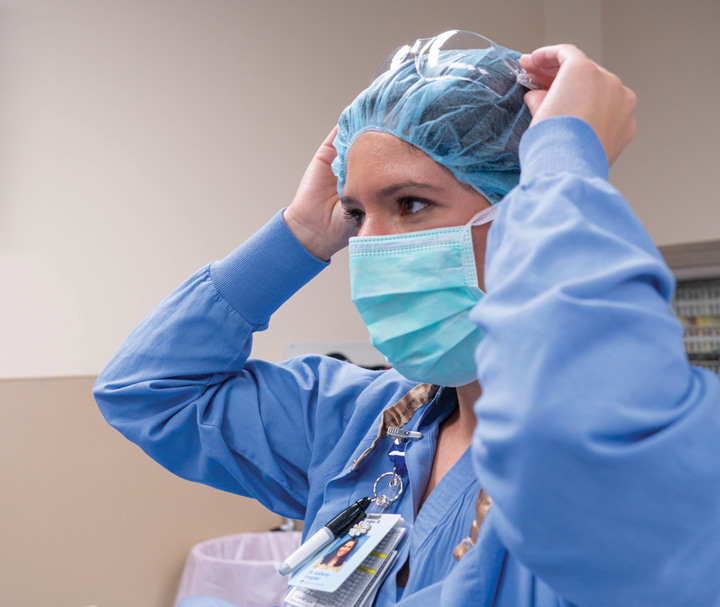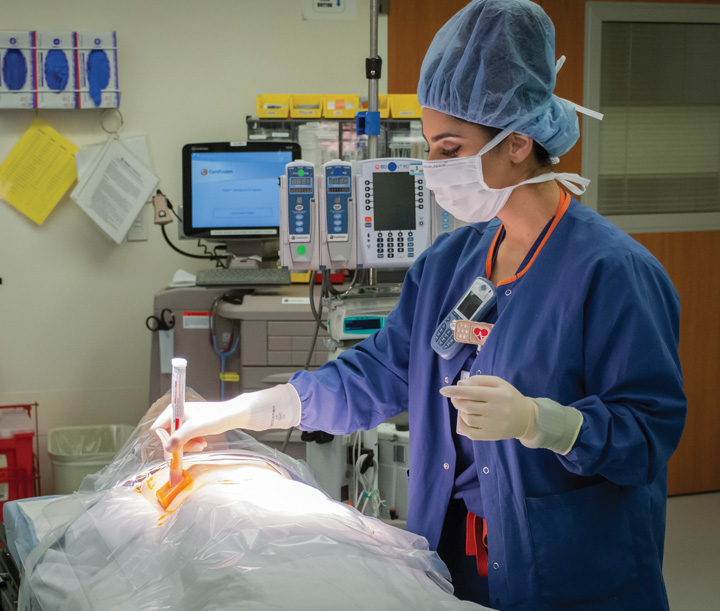- Home
- Article
Refine Your Skin Prepping Protocol
By: Joe Paone | Senior Editor
Published: 5/16/2023
All surgical facilities have “skin in the game” when it comes to SSI prevention.
Surgical site infections (SSIs) can be reduced when leaders standardize the preoperative skin preparation solutions and protocols their OR teams use. Problem is, a variety of ambiguities have created wide variations in everyday skin prep practices.
Reset your practices
Karen deKay, MSN, RN, CNOR, CIC, senior perioperative practice specialist with the Association of periOperative Registered Nurses (AORN), led efforts to update the Preoperative Patient Skin Antisepsis Guideline in May 2021. Here are the main updates:
• Use alcohol-based skin preps combined with another antiseptic. AORN now recommends use of an alcohol-based skin antiseptic unless contraindicated, a practice also supported by the CDC, WHO, the National Institute for Health and Care Excellence and the Society for Healthcare Epidemiology of America. However, while alcohol is bactericidal, its antiseptic action doesn’t last very long.
In light of this, AORN recommends applying a dual agent that combines alcohol with another antiseptic, as it ensures rapid and persistent action for reduction of skin microorganisms at the surgical site. “Alcohol by itself is a good antiseptic that reduces both gram positive and gram negative organisms, but it works really quickly and then evaporates,” says Ms. deKay. “When combined with another antiseptic such as chlorhexidine gluconate (CHG) or povidone-iodine, that second antiseptic will remain on skin longer and has residual effects. If you have a four-hour procedure, it will continue to be present instead of just evaporating. You get more bang for your buck.”
Before selecting an alcohol-based prep, AORN recommends reviewing the manufacturer’s instructions for use (IFU) and assessing the surgical site for inclusion or close proximity to areas of mucosa, open wounds or the patient’s corneas or ears, as certain antiseptics may be contraindicated in these areas. It also recommends an alternative to alcohol-based prep in cases where the required dry time is likely inefficient or unachievable, particularly in cases when it might not be feasible or desired to remove large amounts of hair.
• The antiseptic should be visible on the patient’s skin. AORN previously recommended using tinted antiseptics, which are more visible than those that are clear. It has refined that recommendation to account for variability in patients’ skin tones that may make certain antiseptics difficult to distinguish from untreated skin.
“It’s easier to see the antiseptic if it has a color to it,” says Ms. deKay. “That way, you can make sure you’re covering the area adequately.” However, AORN and many providers have noted that certain tinted antiseptics aren’t as visible on various skin tones. “One study tested two different colors of antiseptics — one orange, and one teal,” says Ms. deKay. “It found orange-tinted antiseptic showed up better on fair and medium-fair skin, while teal-tinted antiseptic showed up better on medium-dark and dark skin. Povidone-iodine, for example, is orange in color, so you may not be able to see the barriers as well on dark skin.”
If you plan to shift to all povidone-iodine skin prep products, consider the different colors of skin its diverse patients have, and also stock an alternately colored antiseptic like CHG.

• Before draping, move solution-soaked materials away from the bed — but not out of the OR entirely. The 2018 National Fire Protection Association’s NFPA 99 instructed facilities to remove all alcohol-based solution-soaked materials from the OR prior to draping and the use of electrosurgery or a laser — a concept also adopted by The Joint Commission.
However, that conflicted with recommendations from AORN about avoiding unnecessary door openings in the OR. AORN worked with NFPA and patient safety/quality organization ECRI to address this discrepancy. The 2021 version of NFPA 99 now states that solution-soaked materials should be “removed from the patient care vicinity” — defined as a six-foot circumference around the OR bed. “That way, when we perform electrosurgery or use a laser, it’s far enough away that a spark couldn’t ignite the materials,” says Ms. deKay.
• Cover your arms — if you choose. AORN previously recommended that providers’ arms always be covered during skin preps to avoid body hair or shedding skin from falling onto the surgical site. It also recommended that anyone in the OR who isn’t scrubbed should wear long sleeves as well — even if they aren’t prepping skin.
AORN has since shifted to a more conditional recommendation: Arms may be covered during skin preps. “We got a lot of pushback from surgeons and hospitals because of the cost to buy long-sleeve jackets,” says Ms. deKay. “Also, the evidence wasn’t strong that wearing long-sleeve jackets could be linked to a reduction in SSIs. So we made long sleeves during application of skin antisepsis a conditional recommendation that is up to the individual facility.” However, Ms. deKay notes that a facility seeing a rise in staph infections, which shed from skin, might want to consider implementing a long sleeves requirement to see if it reduces its infection rate.
• The benefits of sequential application are unproven. AORN does not recommend that providers repeat the entire surgical skin preparation with the same or different antiseptic solution before making an incision. “Some surgeons feel that the more layers of antiseptic they put on, the better to prevent SSIs,” says Ms. deKay. “When reviewing the literature, however, there was conflicting evidence and limited evidence that found it resulted in an SSI reduction.”
Some researchers also worry about the effects that sequential application can have on patients’ skin. “There are concerns, especially with children, that applying layers and layers of wetness could destroy their skin integrity,” says Ms. deKay.
Sequential application also wastes time and money. “At an ASC especially, that’s important,” says Ms. deKay. “From the provider’s perspective, they think, ‘One prep takes me 10 minutes, and now they want me to do another one? That’s going to affect my turnover and the number of cases I can do.’”
• Removing hair from the surgical site. If hair removal is unnecessary for the procedure, it shouldn’t be done, says Ms. deKay. That depends on the provider making proper assessments. “You want to remove hair that would interfere with the incision,” she says. “If hair is close to the incision and the surgeon might not be able to see it, remove it. If it’s going to cause a problem for the dressing adhering, remove more. You also must look at the amount and thickness of the hair because it will be different for, say, an elderly 80-year-old woman versus a 20-year-old male.”
If hair removal is necessary, AORN recommends using a clipper to remove hair as close to the surgical site as possible. Hair removal should be performed before the patient is brought to the OR so clippings don’t become airborne and disperse around the room, with some exceptions. “If you’re doing a gynecological procedure, for example, and really don’t want to clip in the pre-op area, you can clip in the OR,” says Ms. deKay. “We recommend using a vacuum-assist device that draws the hair into the vacuum, wetting the hair before clipping it, or using an adhesive mitt device that clipped hair sticks to instead of dispersing.”
Additional suggestions

AORN’s guidelines are evidence-based, and unfortunately relevant studies about certain aspects of skin prep have yet to emerge. Ms. deKay, however, offers these clarifications.
• Advance time. There’s not enough evidence to make a definitive statement beyond that prepping agents should be applied before beginning the procedure. “I couldn’t find any studies that said it needs to be 10 minutes before or 20 minutes before,” says Ms. deKay. “The key is to allow enough time to apply any antiseptic you are using by following its IFU. You might need to apply it for two or three minutes, and then allow a specific amount of time for it to dry. If you rush, it’s not going to be as effective.”
To better ensure that both application and dry times are followed specifically per the IFU, Ms. deKay recommends using a digital timer. “‘Three minutes’ to one provider and ‘three minutes’ to another might be different,” she says. “With a timer, the provider will know exactly how much time has passed.”
• Application method. “With some, the antiseptic is applied with a back-and-forth motion, for others it’s a scrub motion, for others you’re painting it like a picture,” says Ms. deKay. “Follow the IFU for each antiseptic you use.”
• Amount. “If you have a pregnant 200-pound woman and an elderly 100-pound woman, the amount of antiseptic you should use for each should differ,” says Ms. deKay. “Many applicators come in 26 ml versions, which may be too much for the 100-pound woman but not enough for the 200-pound woman. Look at the IFU to see where and how much area the antiseptic needs to cover. It’s like Goldilocks: You don’t want to use too much, and you don’t want to use too little to adequately cover the area.”
Overuse is not only wasteful but potentially dangerous. “If you use too much, it’s going to pool and you have a chance for fire because the patient is sitting in alcohol-soaked solution,” says Ms. deKay. “Take prepping the side of the neck, for example. You shouldn’t use 26 ml because that’s way too much. Use a smaller applicator — 10 ml, for example.” Ms. deKay says this can be a problem especially at small ASCs that might only order 26 ml applicators, and its providers might feel duty-bound to use their entire contents.
• Drip towels. Ms. deKay says it’s vital that antiseptic doesn’t absorb into the sheet underneath the patient, creating the risk of ignition in the OR. Excess solution can be absorbed by applying drip towels in the prep area along the side of the bed. However, providers must remember to remove the drip towels before the patient is draped.
• Auditing. “Sometimes I think we overwhelm people with auditing,” says Ms. deKay, who recommends intermittent audits, especially when SSIs are on the rise. More important in her view: Reset and recommunicate skin prep policies, protocols and products yearly, not only to keep up with the latest developments and findings, but also to get everyone back on the same page. “Start again with an even playing field,” she says. “Tell people what they’re going to use, provide the instructions and then check off people. It’s important that you have education, you have policies, and that they’re repeated on a regular basis.”
That plays into a larger issue: Variability in practices among facilities and providers within the same facility. “If I were educated on skin prep five years ago, the practice could have changed,” says Ms. deKay. “That’s why it should be a yearly competency. Otherwise there might be a more experienced nurse saying, ‘Well, this is how I do it,’ and that nurse teaches a new nurse, and then the new nurse teaches the next nurse.” OSM
.svg?sfvrsn=be606e78_3)
.svg?sfvrsn=56b2f850_5)